Ultrabook Head to Head: Acer Aspire S3 vs. ASUS UX31E
by Jarred Walton & Manveer Wasson on December 21, 2011 5:40 AM ESTNetbook Levels of Battery Life
When netbooks came on the scene, they made the idea of a $1000+ ultraportable seem rather laughable. Several years later we’re rebranding ultraportables as ultrabooks (provided they have Intel Inside) and giving it another go. Of course, ultrabooks pack a few tricks like SSDs for better battery life and performance, and Intel’s ULV Sandy Bridge processors are proving to be very efficient when it comes to saving power. We ran our usual suite of battery life tests, with the LCDs set to as close to 100 nits as possible (50% brightness on the Acer S3 and 18% brightness on the ASUS UX31E).
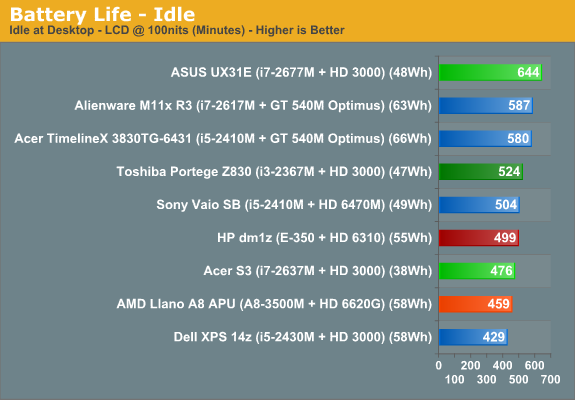
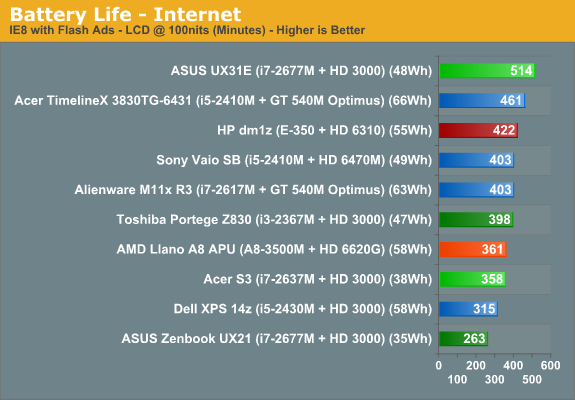
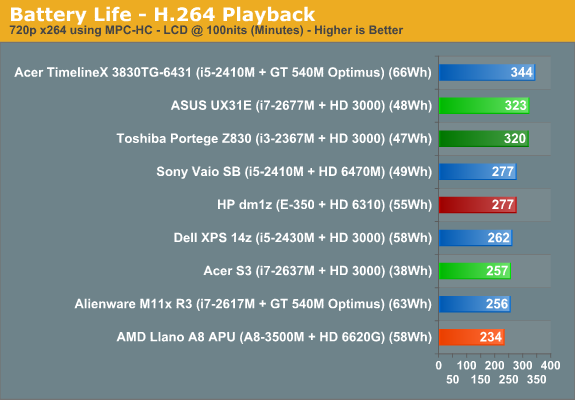
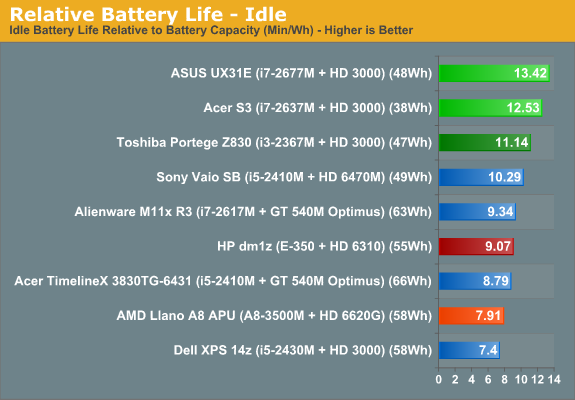
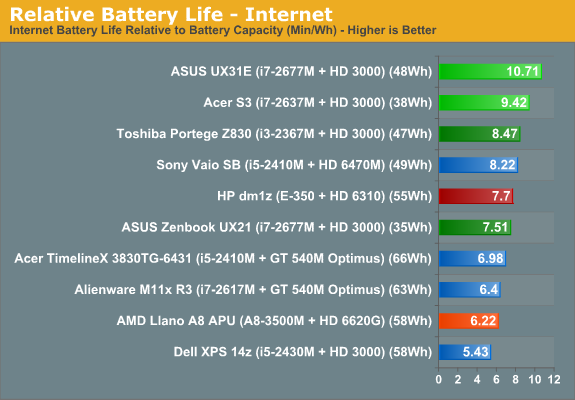

The Acer has a much smaller 3-cell battery, but even with a 38Wh capacity it still boasts respectable battery life of over four hours of H.264 playback and nearly eight hours of idle time. Switch over to the UX31E and not only do you get a higher battery capacity, you also get apparently better power optimizations. In our H.264 test the ASUS “only” manages close to 5.5 hours of playback, while it jumps to 8.5 hours of Internet surfing and over 10.5 hours of idle time. Look at the relative battery life charts and the results are even more impressive: the three ultrabooks we’ve reviewed place at the top of the charts, and even if we compare with Atom, the UX31E matches and sometimes exceeds what the best netbooks could achieve; the other two ultrabooks where we’ve done full reviews also place near the top of our relative battery life charts.
Something else we tested that we don’t have in the above charts is idle battery life with the LCD at maximum brightness. The Acer drops to 400 minutes, but then it only gets about 120% brighter as we’ll see on the next page. The UX31E on the other hand does a swan dive down to just 357 minutes, but you have to take into consideration the 450% increase in brightness. Put another way, power draw for the Acer is around 4.7W at 107 nits (50%) and 5.59W at 234 nits (100%); the ASUS on the other hand uses 4.38W at 93 nits (18%) and jumps up to 7.91W at 519 nits (100%). Even though that’s a pretty big jump in power use, we still have to credit the LED backlighting technology: 500+ nits for less than 5W of power isn’t really that bad.
The short summary here is that you may have to pay more, but you do get substantially better performance than a netbook, you don’t sacrifice much in the size or battery life departments, and build quality is generally far higher than inexpensive laptops and netbooks. Does that make ultrabooks a better option than other laptops? Not for everyone, but there are certainly people that will like what ultrabooks have to offer.










81 Comments
View All Comments
twotwotwo - Wednesday, December 21, 2011 - link
I had the same experience with the Eee Pad Transformer dock. I was surprised, because it looked a lot like the Eee 10" netbook keyboard, whose keys take very little pressure (in fact, between the small size and the light touch, you tend to get extra keystrokes on the netbook). I half suspect ASUS of angling for reviewer points for "feeling solid" when they made their more recent keyboards only work if you smack the keys. :)(I think ASUS did great overall. Software updates came out quickly, docking's nice, good price, etc., etc. But those keys: not so great.)
So--dear ASUS, premium means never having to smack the keyboard to type. Best wishes, two AnandTech commenters.
snuuggles - Thursday, December 22, 2011 - link
I suspect I am the (or one of the) people Jarred mentioned having returned my UX31 because of the keyboard. I had exactly the same issue you are having, and it was basically unusable to me--I simply couldn't do my work on the machine!Quick question, I found that pressing the bottom left corner of the enter key didn't register. This was repeatable and not because I was hitting it "too quickly", I could press the key all the way down and hold it with no response... can you replicate this? I'm guessing that this type of issue could become less and less of an issue as the keys "loosen up", but who knows, it could become *more* frequent!
I gave Jarred a hard time about recommending the UX31 in the holiday special, I was a little harsh, but I think my criticism stands: this is a mechanically flawed keyboard, and I'm not really sure how you can "look past" this issue and recommend it based on all it's other (great) features.
JarredWalton - Friday, December 23, 2011 - link
If I push on the very corner of the enter (and I mean the *very* corner), it won't register, but even an eighth of an inch in and it works fine. I will agree that the keyboard requires a bit more of a firm touch than on other laptops I've used, but it didn't bother me much. The Acer keyboard behaved similarly in my experience -- if you're a light typist, you'll miss key presses on occasion with either one. I'm sure other people will be fine with it, and some will probably even like it -- we've had people say they like Acer's floating island keys for example. I've seen the UX31E at Best Buy, so if you're picky about keyboards but are still considering the Zenbook, see if you can find some local store where you can try one out in person. Of course, that's my advice on most laptops if you're a discerning users. :-)twotwotwo - Saturday, December 24, 2011 - link
I forget that grown-ups might be reading while I snark. :) For the record, if the UX31's KB is like the original Transformer's, I wouldn't actually recommend someone avoid it just 'cause of that. Yes, checking seems reasonable.Toughbook - Wednesday, December 21, 2011 - link
It's about time someone started to offer some brighter displays. In this day and time of technology it baffles me as too why they are all stuck on the 200-250 NIT rating. I am so spoiled by my 1100 NIT display that when I have to do some work on a 200 NIT machine I feel like I can hardly see it. Being able to have a port replicator would be nice a well on these. Another feature I use almost daily. Drop it in and your done.With all that being said... We still must remember what these machines are designed for. Ultra portability. It's like wanting more leg room or trunk space in a 2 seat sports car. Something has got to give.
I can't seem to under stand what Jarred means by the Windows sticker on the power brick? I'm am totally missing something here....
Great review Jarred, keep up the good work.
JarredWalton - Friday, December 23, 2011 - link
The power brick has the Windows Certificate of Authenticity (with the license key) on it. Usually those are on the bottom of the laptop or under the battery; obviously the latter isn't an option, but moving it onto the power brick doesn't really make a lot of sense to me.geotwn - Wednesday, December 21, 2011 - link
Reading Anandtech for years I wonder why the Thinkpad X220 review is missing for long time. IMHO the IPS models beat all of the light-weight notebook hand down in terms of screen quality - it ought to be the standard to compete against if we are serious about display, but it does not get reviewed or even mentioned.JarredWalton - Thursday, December 22, 2011 - link
Because Lenovo won't send us one; it's as simple as that.twotwotwo - Wednesday, December 21, 2011 - link
Via Gizmodo, I saw a detailed tablet display comparison today (search for "Tablet Display Technology Shoot-Out" to find two different comparisons). They argue the raw contrast ratio is "Only relevant for low ambient light, which is seldom the case for mobile devices," and they measure the intensity of mirror-like and other reflections from the screen. Only the Galaxy Tab, iPad 2 and (to my surprise) Nook Tablet came out under 11% mirror reflections.I knew something bugged me about raw contrast numbers and this is it: backlight bleed is often less of a problem than reflections. Would be interesting to see, if not a detailed mirror-reflection test like that site does, at least contrast measurements that factor in reflections under whatever "indoor" and "outdoor" ambient-light levels you define.
Know lots of work goes into the measurements and it's not easy to just throw another figure in. Does seem like factoring in how much reflection you'll be seeing could potentially lead to more useful numbers.
JarredWalton - Thursday, December 22, 2011 - link
This is why I point out the high maximum brightness of the ASUS -- that makes up for most reflections (unless you're looking at a dark scene/image/movie). Of course, in direct sunlight it's probably still not enough (I'd say 1200 nits would be needed for such use), but it's brighter and more usable outside than 99% of laptops.